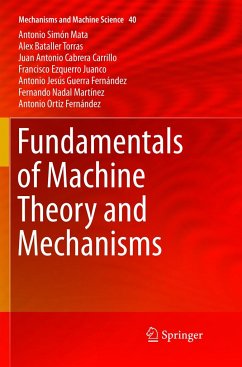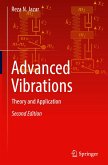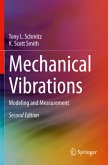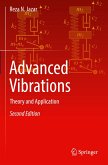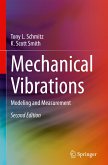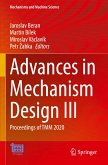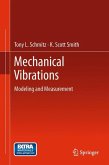Antonio Simón Mata, Alex Bataller Torras, Juan Antonio Cabrera Carrillo
Fundamentals of Machine Theory and Mechanisms
Antonio Simón Mata, Alex Bataller Torras, Juan Antonio Cabrera Carrillo
Fundamentals of Machine Theory and Mechanisms
- Broschiertes Buch
- Merkliste
- Auf die Merkliste
- Bewerten Bewerten
- Teilen
- Produkt teilen
- Produkterinnerung
- Produkterinnerung
This book develops the basic content for an introductory course in Mechanism and Machine Theory. The text is clear and simple, supported by more than 350 figures. More than 60 solved exercises have been included to mark the translation of this book from Spanish into English. Topics treated include: dynamic analysis of machines; introduction to vibratory behavior; rotor and piston balanced; critical speed for shafts; gears and train gears; synthesis for planar mechanisms; and kinematic and dynamic analysis for robots. The chapters in relation to kinematics and dynamics for planar mechanisms can…mehr
Andere Kunden interessierten sich auch für
![Advanced Vibrations Advanced Vibrations]() Reza N. JazarAdvanced Vibrations97,99 €
Reza N. JazarAdvanced Vibrations97,99 €![Mechanical Vibrations Mechanical Vibrations]() Tony L. SchmitzMechanical Vibrations49,99 €
Tony L. SchmitzMechanical Vibrations49,99 €![Advanced Vibrations Advanced Vibrations]() Reza N. JazarAdvanced Vibrations69,99 €
Reza N. JazarAdvanced Vibrations69,99 €![Mechanical Vibrations Mechanical Vibrations]() Tony L. SchmitzMechanical Vibrations81,99 €
Tony L. SchmitzMechanical Vibrations81,99 €![Advances in Mechanism Design III Advances in Mechanism Design III]() Advances in Mechanism Design III161,99 €
Advances in Mechanism Design III161,99 €![Advances in Mechanism Design IV Advances in Mechanism Design IV]() Advances in Mechanism Design IV201,99 €
Advances in Mechanism Design IV201,99 €![Mechanical Vibrations Mechanical Vibrations]() Tony L. SchmitzMechanical Vibrations81,99 €
Tony L. SchmitzMechanical Vibrations81,99 €-
-
-
This book develops the basic content for an introductory course in Mechanism and Machine Theory. The text is clear and simple, supported by more than 350 figures. More than 60 solved exercises have been included to mark the translation of this book from Spanish into English. Topics treated include:
dynamic analysis of machines; introduction to vibratory behavior; rotor and piston balanced; critical speed for shafts; gears and train gears; synthesis for planar mechanisms; and kinematic and dynamic analysis for robots. The chapters in relation to kinematics and dynamics for planar mechanisms can be studied with the help of WinMecc software, which allows the reader to study in an easy and intuitive way, but exhaustive at the same time. This computer program analyzes planar mechanisms of one-degree of freedom and whatever number of links. The program allows users to build a complex mechanism. They can modify any input data in real time changing values in a numeric way or usingthe computer mouse to manipulate links and vectors while mechanism is moving and showing the results. This powerful tool does not only show the results in a numeric way by means of tables and diagrams but also in a visual way with scalable vectors and curves.
dynamic analysis of machines; introduction to vibratory behavior; rotor and piston balanced; critical speed for shafts; gears and train gears; synthesis for planar mechanisms; and kinematic and dynamic analysis for robots. The chapters in relation to kinematics and dynamics for planar mechanisms can be studied with the help of WinMecc software, which allows the reader to study in an easy and intuitive way, but exhaustive at the same time. This computer program analyzes planar mechanisms of one-degree of freedom and whatever number of links. The program allows users to build a complex mechanism. They can modify any input data in real time changing values in a numeric way or usingthe computer mouse to manipulate links and vectors while mechanism is moving and showing the results. This powerful tool does not only show the results in a numeric way by means of tables and diagrams but also in a visual way with scalable vectors and curves.
Produktdetails
- Produktdetails
- Mechanisms and Machine Science 40
- Verlag: Bellisco / Springer / Springer International Publishing / Springer, Berlin
- Artikelnr. des Verlages: 978-3-319-81166-6
- Softcover reprint of the original 1st ed. 2016
- Seitenzahl: 424
- Erscheinungstermin: 30. Mai 2018
- Englisch
- Abmessung: 235mm x 155mm x 23mm
- Gewicht: 646g
- ISBN-13: 9783319811666
- ISBN-10: 3319811665
- Artikelnr.: 53573944
- Herstellerkennzeichnung
- Books on Demand GmbH
- In de Tarpen 42
- 22848 Norderstedt
- info@bod.de
- 040 53433511
- Mechanisms and Machine Science 40
- Verlag: Bellisco / Springer / Springer International Publishing / Springer, Berlin
- Artikelnr. des Verlages: 978-3-319-81166-6
- Softcover reprint of the original 1st ed. 2016
- Seitenzahl: 424
- Erscheinungstermin: 30. Mai 2018
- Englisch
- Abmessung: 235mm x 155mm x 23mm
- Gewicht: 646g
- ISBN-13: 9783319811666
- ISBN-10: 3319811665
- Artikelnr.: 53573944
- Herstellerkennzeichnung
- Books on Demand GmbH
- In de Tarpen 42
- 22848 Norderstedt
- info@bod.de
- 040 53433511
The Spanish language original version of this book, written by the same authors, has seen four editions already and has been used in many universities in Spain and Latin America for years. Antonio Simón received his B.S., M.S., and Ph.D. degrees in Aeronautical Engineering from the Polytechnic University of Madrid, Spain. He is currently a Professor of Mechanical Engineering at the University of Malaga, Spain, and he is the Head of the Mechanical Engineering Department at Malaga University. His research interests include modeling and control of vehicle systems, advanced vehicle systems, genetic algorithms applied to mechanisms and tire models, and biomechanics. Alex Bataller got his Degree in Mechanical Engineering at the University of Malaga in 1983. Afterwards, he worked as Assistant Professor at the same university, teaching Kinematics and Dynamics of Machines. In 1987 he became Associate Professor and since then he has been teaching Theory of Mechanisms and Machines. In 1986 he developed an educational software program for the kinematic and dynamic analysis of mechanisms called MecC. That was the origin of the WinMecC software, which is currently used in many universities. At present, his research is focused on the synthesis of mechanisms with genetic algorithms for medical applications. Juan A. Cabrera received his B.S. Degree in Mechanical Engineering, his M.S. Degree in Computer Science, and his Ph.D. Degree in Mechanical Engineering from the University of Malaga, Spain. He is currently Associate Professor of Mechanical Engineering at the University of Malaga. His research interests include modeling and control of vehicle systems, advanced vehicle systems, genetic algorithms applied to mechanisms and tire models, and multiobjective evolutionary strategies. Francisco Ezquerro Juanco is Professor of Mechanical Engineering at the University of Málaga. He obtained his M.S. Degree in Mechanical Engineering at the University of Basque Country (UPV/EHU) and his Ph.D. Degree at the University of Malaga. His research activities lie in the area of Biomechanics. Antonio J. Guerra received his B.S. Degree in Mechanical Engineering from the University of Malaga, Spain, and his M.S. Degree in Photovoltaic Solar Energy System Technology from the International University of Andalucía, Spain. He is currently an Associate Professor of Mechanical Engineering at the University of Malaga. His research interests include modeling and control of vehicle systems. He also works on machine design, test benches and test elements. Fernando Nadal received his M.S. Degree in Industrial Electronics and Automation Engineering and his Ph.D. Degree in Mechanical Engineering from the University of Malaga, Spain. He is currently Associate Professor of Mechanical Engineering at the University of Malaga. His research interests include development of mechanism simulation software, genetic algorithms applied to mechanisms and multiobjective evolutionary strategies. Antonio Ortiz received his B.S. and M.S. Degrees in Mechanical Engineering from the Polytechnic University of Madrid, Spain, in 1995 and his Ph.D. Degree from the University of Malaga, Spain in 2005. He is currently Associate Professor of Mechanical Engineering at the University of Malaga.
Chapter 1 Kinematic Chains.- 1.1 Basic Concepts.- 1.2 Definitions.- 1.3 Degrees of Freedom of Mechanisms.- 1.4 Kinematic Inversions.- 1.5 Grashof's Criterion.- 1.6 Mechanical Advantage.- 1.7 Kinematic Curves.- 1.8 Application of Different Mechanisms with Different Purposes.- Chapter 2 Kinematic Analysis of Mechanisms. Relative Velocity and Acceleration. Instant Centers of Rotation.- 2.1 Velocity in Mechanisms.- 2.2 Accelerations in Mechanisms.- 2.3 Exercises with their Solutions.- Chapter 3 Analytical methods for the Kinematic Analysis of Planar Linkages. Raven's Method.- 3.1 Analytical Methods.- 3.2 Examples with their Solutions.- Chapter 4 Graphical and Analytical Methods for Dynamic Analysis of Planar Linkages.- 4.1 Machine Statics.- 4.2 Dynamic Analysis.- 4.3 Dynamic Analysis. Matrix Method.- 4.4 Exercises with Solutions.- Chapter 5 Balancing of Machinery.- 5.1 Rotor Balancing.- 5.2 Inertia Balancing of Single and Multi-Cylinder Engines.- 5.3 Problems with Solutions.- Chapter 6 Flywheel Calculations.- 6.1 Forces and Torques in Mechanisms.- 6.2 General Equation of Mechanism Motion.- 6.3 Working Periods of a Cyclic Machine.- 6.4 Steady State.- 6.5 Flywheels.- 6.6 Application Examples of Flywheels.- 6.7 Coefficient of Speed Fluctuation.- 6.8 Design of a Flywheel.- Chapter 7 Vibrations in Systems with one Degree of Freedom.- 7.1 Introduction to Oscillatory Motion.- 7.2 Single Degree of Freedom (SDOF) Systems.- 7.3 Free Vibrations in SDOF Systems.- 7.4 Forced Vibrations in SDOF Systems.- Chapter 8 Gears.- 8.1 Introduction.- 8.2 Toothed Wheels (Gears).- 8.3 Condition for Constant Velocity Ratio. Fundamental Law of Gearing.- 8.4 Involute Teeth.- 8.5 Definitions and Nomenclature.- 8.6 Involute Tooth Action.- 8.7 Contact Ratio.- 8.8 Relationship between Velocity Ratio and Base Circles.- 8.9 Interference in Involute Gears.- 8.10 Gear Classification.- 8.11 Manufacturing of Toothed Wheels.- 8.12 Gear Standardization.- 8.13 Helical Gears.- 8.14 Bevel Gears.- 8.15Force Analysis in Toothed Wheels.- Chapter 9 Gear Trains.- 9.1 Classification of Gear Trains.- 9.2 Ordinary Trains.- 9.3 Planetary or Epicyclic Trains.- 9.4 Examples.- Chapter 10 Synthesis of Planar Mechanisms.- 10.1 Types of Synthesis.- 10.2 Function Generation Synthesis.- 10.3 Trajectory Generation Synthesis.- 10.4 Optimal Synthesis of Mechanisms.- 10.5 Analysis of the Objective Function.- 10.6 Optimization Method Based on Evolutionary Algorithms.- 10.7 Results.- Appendix I: Position Kinematic Analysis. Trigonometric Method.- I.1 Position Analysis of a Four-Bar Mechanism.- I.2 Position Analysis of a Crank-Shaft Mechanism.- I.3 Position Analysis of a Slider Mechanism.- I.4 Two Generic Bars of a Mechanism.- Appendix II: Freudenstein's Method to Solve the Position Equations in a Four-Bar Mechanism.- II.1 Position Analysis of a Four-Bar Mechanism by using Raven's Method.- II.2 Freudenstein's Method.- Appendix III: Kinematic and Dynamic Analysis of a Mechanism.- III.1 Kinematic Chain.- III.2 Slider Displacement versus Crank Rotation.- III.4 Velocity Analysis by Relative Velocity Method.- III.4. Instantaneous Center Method for Velocities.- III.5 Acceleration Analysis with the Relative Acceleration Method.- III.6 Raven's Method.- III.7 Mass, Inertia Moments, Inertia Forces and Inertia Pairs.- III.8. Force Analysis. Graphical Method.- III.9 Dynamic Analysis. Matrix Method.
Chapter 1 Kinematic Chains.- 1.1 Basic Concepts.- 1.2 Definitions.- 1.3 Degrees of Freedom of Mechanisms.- 1.4 Kinematic Inversions.- 1.5 Grashof's Criterion.- 1.6 Mechanical Advantage.- 1.7 Kinematic Curves.- 1.8 Application of Different Mechanisms with Different Purposes.- Chapter 2 Kinematic Analysis of Mechanisms. Relative Velocity and Acceleration. Instant Centers of Rotation.- 2.1 Velocity in Mechanisms.- 2.2 Accelerations in Mechanisms.- 2.3 Exercises with their Solutions.- Chapter 3 Analytical methods for the Kinematic Analysis of Planar Linkages. Raven's Method.- 3.1 Analytical Methods.- 3.2 Examples with their Solutions.- Chapter 4 Graphical and Analytical Methods for Dynamic Analysis of Planar Linkages.- 4.1 Machine Statics.- 4.2 Dynamic Analysis.- 4.3 Dynamic Analysis. Matrix Method.- 4.4 Exercises with Solutions.- Chapter 5 Balancing of Machinery.- 5.1 Rotor Balancing.- 5.2 Inertia Balancing of Single and Multi-Cylinder Engines.- 5.3 Problems with Solutions.- Chapter 6 Flywheel Calculations.- 6.1 Forces and Torques in Mechanisms.- 6.2 General Equation of Mechanism Motion.- 6.3 Working Periods of a Cyclic Machine.- 6.4 Steady State.- 6.5 Flywheels.- 6.6 Application Examples of Flywheels.- 6.7 Coefficient of Speed Fluctuation.- 6.8 Design of a Flywheel.- Chapter 7 Vibrations in Systems with one Degree of Freedom.- 7.1 Introduction to Oscillatory Motion.- 7.2 Single Degree of Freedom (SDOF) Systems.- 7.3 Free Vibrations in SDOF Systems.- 7.4 Forced Vibrations in SDOF Systems.- Chapter 8 Gears.- 8.1 Introduction.- 8.2 Toothed Wheels (Gears).- 8.3 Condition for Constant Velocity Ratio. Fundamental Law of Gearing.- 8.4 Involute Teeth.- 8.5 Definitions and Nomenclature.- 8.6 Involute Tooth Action.- 8.7 Contact Ratio.- 8.8 Relationship between Velocity Ratio and Base Circles.- 8.9 Interference in Involute Gears.- 8.10 Gear Classification.- 8.11 Manufacturing of Toothed Wheels.- 8.12 Gear Standardization.- 8.13 Helical Gears.- 8.14 Bevel Gears.- 8.15Force Analysis in Toothed Wheels.- Chapter 9 Gear Trains.- 9.1 Classification of Gear Trains.- 9.2 Ordinary Trains.- 9.3 Planetary or Epicyclic Trains.- 9.4 Examples.- Chapter 10 Synthesis of Planar Mechanisms.- 10.1 Types of Synthesis.- 10.2 Function Generation Synthesis.- 10.3 Trajectory Generation Synthesis.- 10.4 Optimal Synthesis of Mechanisms.- 10.5 Analysis of the Objective Function.- 10.6 Optimization Method Based on Evolutionary Algorithms.- 10.7 Results.- Appendix I: Position Kinematic Analysis. Trigonometric Method.- I.1 Position Analysis of a Four-Bar Mechanism.- I.2 Position Analysis of a Crank-Shaft Mechanism.- I.3 Position Analysis of a Slider Mechanism.- I.4 Two Generic Bars of a Mechanism.- Appendix II: Freudenstein's Method to Solve the Position Equations in a Four-Bar Mechanism.- II.1 Position Analysis of a Four-Bar Mechanism by using Raven's Method.- II.2 Freudenstein's Method.- Appendix III: Kinematic and Dynamic Analysis of a Mechanism.- III.1 Kinematic Chain.- III.2 Slider Displacement versus Crank Rotation.- III.4 Velocity Analysis by Relative Velocity Method.- III.4. Instantaneous Center Method for Velocities.- III.5 Acceleration Analysis with the Relative Acceleration Method.- III.6 Raven's Method.- III.7 Mass, Inertia Moments, Inertia Forces and Inertia Pairs.- III.8. Force Analysis. Graphical Method.- III.9 Dynamic Analysis. Matrix Method.

